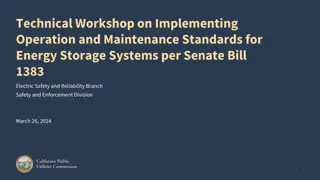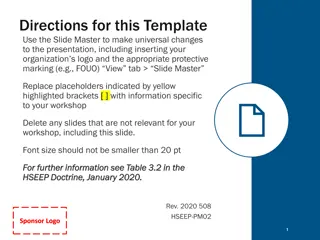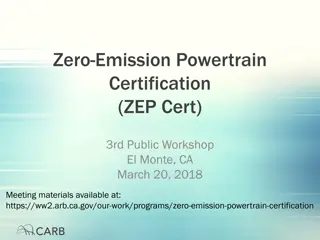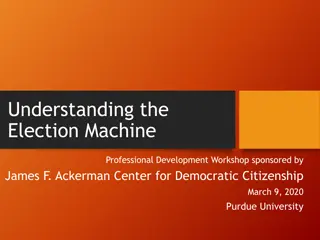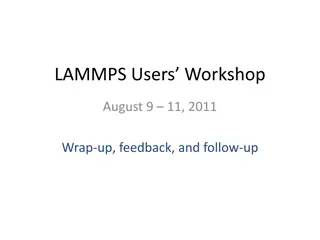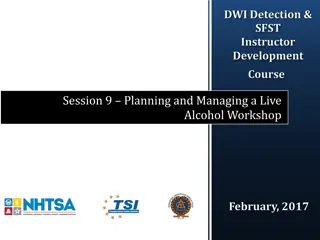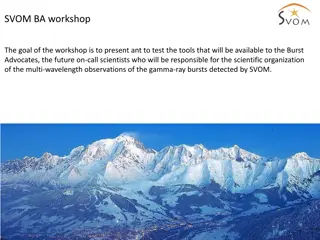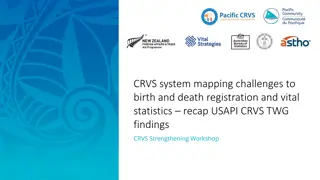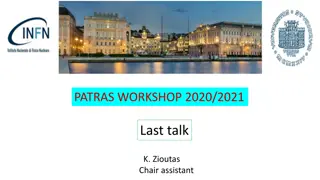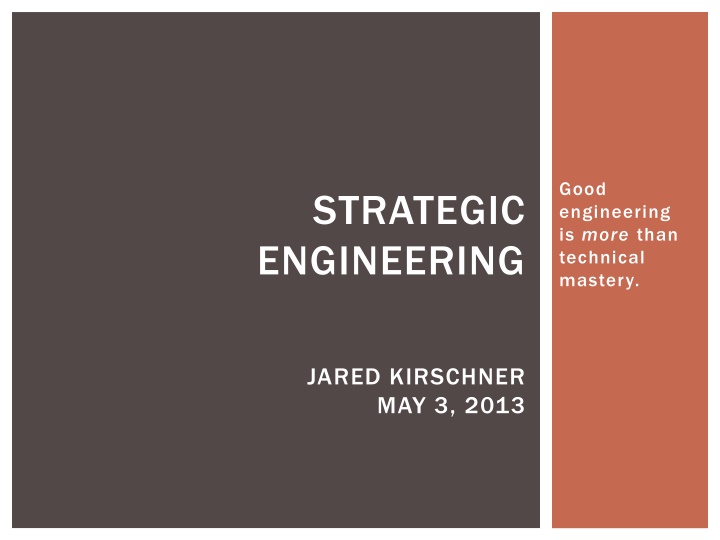
Strategic Engineering and Its Importance in Problem Solving
Learn about the concept of strategic engineering, which involves solving problems by balancing conflicting specifications to achieve clear goals. Discover how strategic engineers navigate uncertainty to create innovative solutions.
Download Presentation

Please find below an Image/Link to download the presentation.
The content on the website is provided AS IS for your information and personal use only. It may not be sold, licensed, or shared on other websites without obtaining consent from the author. If you encounter any issues during the download, it is possible that the publisher has removed the file from their server.
You are allowed to download the files provided on this website for personal or commercial use, subject to the condition that they are used lawfully. All files are the property of their respective owners.
The content on the website is provided AS IS for your information and personal use only. It may not be sold, licensed, or shared on other websites without obtaining consent from the author.
E N D
Presentation Transcript
Good engineering is more than technical mastery. STRATEGIC ENGINEERING JARED KIRSCHNER MAY 3, 2013
WHAT DO YOU MEAN STRATEGIC ENGINEERING ? What defines an engineer?
WHAT DO YOU MEAN STRATEGIC ENGINEERING ? Engineering is the art of building something not previously in existence that solves a problem. An Engineer Engineering is the art of trading off specs. A Wise Engineer
WHAT DO YOU MEAN STRATEGIC ENGINEERING ? Strategy. noun. A high level plan to achieve one or more goals under conditions of uncertainty. -- Wikipedia What makes an engineer strategic?
WHAT DO YOU MEAN STRATEGIC ENGINEERING? Strategic engineers solve a problem solve a problem while satisfying a variety of potentially conflicting specifications potentially conflicting specifications. Specifications fall into multiple broad categories: Clear Clear Goals Low Low Unclear Unclear Goals High High Uncertainty Technical Technical Project Project Product Product Strategic Strategic Uncertainty
TECHNICAL SPECIFICATIONS Can we solve the problem? Is it possible? Examples Power Speed Torque Size Tolerance Strength Lifetime Temperature Ductility Throughput Gain Latency Phase Margin Amplitude Mismatch Hardness Strain Stress Impedance Compatibility Clear Clear Goals Low Low Unclear Unclear Goals High High Uncertainty Technical Technical Project Project Product Product Strategic Strategic Uncertainty
PROJECT SPECIFICATIONS How do I solve the problem with my resources and constraints? Examples Budget Deadlines Person-hours Equipment Skills Experience Motivation Confidence Infrastructure Materials Advisors Contractors Consultants Suppliers Manufacturers Distributors Clear Clear Goals Low Low Unclear Unclear Goals High High Uncertainty Technical Technical Project Project Product Product Strategic Strategic Uncertainty
PRODUCT SPECIFICATIONS Am I solving the right problem? Examples User research Target market Personas Function Interaction Character Branding Marketing Differentiation Comparables Price point Profit margin Clear Clear Goals Low Low Unclear Unclear Goals High High Uncertainty Technical Technical Project Project Product Product Strategic Strategic Uncertainty
STRATEGIC SPECIFICATIONS Am I solving the right problem the right way? Nature Value Chain Supporting Environment People Company Employees Economy Assets Government Clear Clear Goals Low Low Unclear Unclear Goals High High Uncertainty Technical Technical Project Project Product Product Strategic Strategic Uncertainty
STRATEGIC SPECIFICATIONS Supporting Environment Company Nature Value Chain People Employees Economy Assets Government How does the supporting environment interact with the company?
STRATEGIC SPECIFICATIONS Supporting Environment Company Ifyou ve got a business, you didn t build that! President Obama (out of context) Nature: Resources Waste management Environmental services People: Talent / labor Customers Reputation Social license to operate Government: Regulations Protection of property Fees & taxes Subsidies Infrastructure Economy: Competitors Partners Business stability Credit
STRATEGIC SPECIFICATIONS How does the company interact with the supporting environment? Nature Value Chain People Employees Economy Supporting Environment Assets Government Company
STRATEGIC SPECIFICATIONS People: Jobs Products Services Government: Revenue Economy: Activity Supporting Environment Company Clear Clear Goals Low Low Uncertainty
STRATEGIC SPECIFICATIONS Nature: Pollution Waste Resource depletion Ecosystem disruption People: Human health impacts Government: Lobbying Economy: Market distortion People: Jobs Products Services Government: Revenue Economy: Activity Supporting Environment Company Clear Clear Goals Low Low Uncertainty
STRATEGIC SPECIFICATIONS Nature: Pollution Waste Resource depletion Ecosystem disruption People: Human health impacts Government: Lobbying Economy: Market distortion People: Jobs Products Services Government: Revenue Economy: Activity But as an engineer, why should I care? Supporting Environment Company Clear Clear Goals Low Low Uncertainty
STRATEGIC SPECIFICATIONS While the implications of strategic choices are uncertain, they have real consequences. Nature Value Chain Supporting Environment People Company Employees Economy Assets Government
THE IMPORTANCE OF STRATEGY Good Strategy Bad Strategy Competitive advantage Strong public image Recognized leadership Increased customer loyalty Decreased financial risk Decreased legal risk Increased margins Increased productivity Product/service failure Poor public image Recognized laggard Poor customer loyalty Increased financial risk Increased legal risk Decreased margins Decreased productivity
THE IMPORTANCE OF STRATEGY Good Strategy Toyota Prius Competitive advantage Strong public image Recognized leadership Increased customer loyalty Decreased financial risk Decreased legal risk Increased margins Increased productivity
THE IMPORTANCE OF STRATEGY Hummer Bad Strategy Product/service failure Poor public image Recognized laggard Poor customer loyalty Increased financial risk Increased legal risk Decreased margins Decreased productivity
THE IMPORTANCE OF STRATEGY Good Strategy Patagonia Competitive advantage Strong public image Recognized leadership Increased customer loyalty Decreased financial risk Decreased legal risk Increased margins Increased productivity
THE IMPORTANCE OF STRATEGY Eastman Kodak Bad Strategy Product/service failure Poor public image Recognized laggard Poor customer loyalty Increased financial risk Increased legal risk Decreased margins Decreased productivity
THE IMPORTANCE OF STRATEGY Good Strategy Chevron Competitive advantage Strong public image Recognized leadership Increased customer loyalty Decreased financial risk Decreased legal risk Increased margins Increased productivity
THE IMPORTANCE OF STRATEGY Furniture Foam Bad Strategy Product/service failure Poor public image Recognized laggard Poor customer loyalty Increased financial risk Increased legal risk Decreased margins Decreased productivity
THE IMPORTANCE OF STRATEGY Good Strategy Nucor Competitive advantage Strong public image Recognized leadership Increased customer loyalty Decreased financial risk Decreased legal risk Increased margins Increased productivity
THE IMPORTANCE OF STRATEGY U.S. Metal Mining Bad Strategy Product/service failure Poor public image Recognized laggard Poor customer loyalty Increased financial risk Increased legal risk Decreased margins Decreased productivity
THOUGHT EXERCISE Discussion Prompt: You have been chosen to lead a new product development team at DEFAULT Power Tools. The product you will be making is a contractor-grade, cordless drill intended for use by professional craftsmen and tradesmen. As an expert in power tools, you are aware that battery design constrains many of the product decisions of a cordless drill (e.g., weight, cost, power, duration of charge).
THOUGHT EXERCISE Discussion Prompt: What key information is needed to make a good decision for your organization regarding battery design? Why is this information important? Nature Value Chain Supporting Environment People Company Employees Economy Assets Government
CONCLUSION While the implications of strategic choices are uncertain, they have real consequences. Nature Value Chain Supporting Environment People Company Employees Economy Assets Government
CONCLUSION Nature: Pollution Waste Resource depletion Ecosystem disruption People: Human health impacts Government: Lobbying Economy: Market distortion People: Jobs Products Services Government: Revenue Economy: Activity Supporting Environment Company Clear Clear Goals Low Low Uncertainty
CONCLUSION Supporting Environment Company Nature: Resources Waste management Environmental services People: Talent / labor Customers Reputation Social license to operate Government: Regulations Protection of property Fees & taxes Subsidies Infrastructure Economy: Competitors Partners Business stability Credit
CONCLUSION Good Strategy Bad Strategy Competitive advantage Strong public image Recognized leadership Increased customer loyalty Decreased financial risk Decreased legal risk Increased margins Increased productivity Product/service failure Poor public image Recognized laggard Poor customer loyalty Increased financial risk Increased legal risk Decreased margins Decreased productivity
CONCLUSION Questions?


